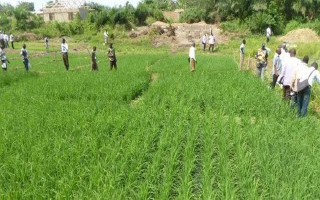Food (in)security Lab – How we engage

The Lab is pioneering new approaches to improving food and nutrition security following the principles of co-development and co-production, bringing together the right people from across the globe and the best available quantitative and qualitative data at local and global levels. This enables us to map out evidence-based pathways to equitable and efficient policies and regulations that improve food security in the context of a changing climate. Our experts produce high-level publications used by decision makers around the world, and have convened special sessions at COP26, COP27, COP28, COP29, and COP30 that included panellists from the Food and Agriculture Organization of the United Nations (FAO), and Burkina Faso, and Bangladesh country delegations.
The co-leads have always worked collaboratively, often with colleagues based in the global south, and are committed to ensuring that their research has far reaching impact. Professor Robinson and Dr Dasgupta are co-authors of the Global Lancet Countdown, and the Lancet Countdown in Europe and SIDS. They lead the food security and undernutrition indicator for the Countdown.
Building long-term partnerships: Example from Burkina Faso
Our partnership began when Mr. Pamoussa Ouedraogo, then Conseiller Technique du Ministre en Charge de l’action humanitaire et de la famille, reached out after attending a webinar featuring Professor Robinson and Dr. Dasgupta on climate change’s impact on child health and nutrition. Highlighting the lack of quantitative evidence for Burkina Faso, Mr. Ouedraogo requested research support to inform government advocacy in international forums.
This led to an invitation from the Burkina Faso government to present our initial findings at COP26 in Glasgow, where we discussed co-producing policy-relevant evidence. At COP28, we shared updated, published results at the Burkina Faso pavilion and engaged with key officials, including HE Mr. Roger Baro, Minister of Environment, Energy, Water and Sanitation, who expressed gratitude for our evidence-building efforts. At COP30, we extended our research to include early warning systems for farmer crop decisions and protection from heat to improve health and health services resilience.
Our work has been supported by the LSE Global Research Fund, LSE International Science Partnership Fund, and COST Action PROCLIAS, funded by the European Cooperation in Science and Technology (COST). Through this multi-year collaboration, GRI-LSE and Burkina Faso’s government have established an equitable partnership focused on improving livelihoods threatened by climate change. This collaboration embodies the Climate Food (In)Security Lab’s commitment to working fairly and effectively with lower-income country partners.
Assembling the evidence on “what works” in the context of improving access to food and nutrition
Climate Vulnerability Monitor (CVM) is an independent global assessment of the impacts of human-induced climate change in the 21st century. The CVM3 presents the data according to climate scenarios and modelling frameworks that are consistent with the IPCC’s Sixth Assessment Report (AR6). We contributed with projections for food (in)security. Our findings suggest that if no climate action is taken, the increase in heatwave events is projected to cause global food insecurity to rise by 12.8 percentage points. The Monitor is used as a tool by development, humanitarian, and aid agencies concerned with addressing the growing impact of climate change around the world, as well as investment and security analysts.
Based on peer-reviewed publication, we co-developed policy briefs and outputs with our collaborators from Burkina Faso. Our findings provide evidence to enable policies to actions and policies to improve food security, nutrition, and child health in Burkina Faso in a changing climate.
Providing practical policy guidance: Examples from African and Asian countries
Burkina Faso: Burkina Faso, a low-income country in the Sahel region of Africa, has improved many of its human development indicators in recent decades, including reducing child mortality rates. This has been achieved in part through investing to improve nutrition and women’s access to health care. However, Burkina Faso is increasingly having to deal with the growing challenges of climate change, which is leading to greater fragility and deepening vulnerabilities, undermining efforts to reduce poverty and increase prosperity. This policy brief highlights priority areas for actionable advances in improving food security, nutrition, and child health in Burkina Faso in the context of a changing climate.
Bangladesh: Across the world climate change is threatening food security, and Bangladesh is no exception. The frequency and intensity of extreme weather events, flooding and extreme heat in the country have a direct negative impact on food production and availability, pushing up prices. In the main, Bangladesh has done well to improve food production and food security in recent years: most measures of food security are moving in the right direction. However, climate change is likely to make future improvements more challenging. This policy brief examines the climate change and food security challenges Bangladesh faces, the trajectory of policy in this area, and how the agriculture sector can contribute to climate change mitigation.
Egypt: Egypt is highly dependent on food from other countries and imports more than 60% of the wheat it consumes. This makes the country particularly vulnerable to shocks and systemic crises along global food supply chains, whether caused by weather and climate-related shocks, such as the successive droughts in Australia in the early 2000s; supply shocks such as the restrictions on wheat exports from Ukraine in 2022; or demand shocks, such as when governments imposed lockdowns in response to COVID-19. Compounding this vulnerability, wheat prices have increased significantly since 2020, reflecting these recent supply shocks. Access to food can be improved through targeted ‘safety nets’, which can comprise either direct cash payments or food assistance, where food is given directly or via instruments such as food stamps or coupons to those in need. Both types of safety net have proven to reduce food insecurity during the COVID-19 pandemic, though cash transfers were more effective, most likely because they targeted COVID-induced loss of income. In many lower-income countries safety nets are increasingly seen as a critical element of improving health and wellbeing more broadly.
Democratic Republic of Congo, Kenya, Uganda, Zambia: These countries are grappling with the triple burden of malnutrition presenting as overnutrition, undernutrition and micronutrient deficiencies. Maternal and child health outcomes are significantly affected by malnutrition with indicators such as iron deficiency anaemia during pregnancy, a significant risk for postpartum haemorrhage, low birth weight, premature birth and potential developmental challenges for the child and, stunting, among other adverse outcomes. Health system issues such as limited or inequitable access to healthcare and nutrition programs hinders efforts to address malnutrition. While these are amenable to a range of interventions, climate change poses a greater threat to these population groups. Traditional approaches to the implementation of existing interventions, such as iron and folic acid (IFA) supplementation for pregnant women through the antenatal care (ANC) platform and awareness programs to diversity agricultural systems and diets have not achieved the intended impact. For example, while IFA coverage is high, adherence to the supplements and other ANC interventions remains low. Further, IFA only provides two supplements while the range of deficiencies has increased over time with changes in food production systems coupled by climate change. The World Health Organisation in 2021 issued guidelines for countries to introduce Multiple Micronutrient Supplementation (MMS), specifically the United Nations International Multiple Micronutrient Antenatal Preparation (UNIMMAP) MMS specification which contains 15 vitamins and minerals. Using implementation research, we are generating contextually relevant evidence to support the introduction and scale up of MMS to addresses the high burden of maternal undernutrition and micronutrient deficiencies in sub-Saharan Africa in these countries.
Kenya, Nigeria & Tanzania: This initiative targets adolescent girls and young mothers in fragile, climate-impacted settings, addressing both nutrition-specific and nutrition-sensitive interventions. The project use implementation science approaches to and co-create strategies to: Improve dietary diversity and micronutrient intake through fortified foods, supplements, and nutrition education; Integrate reproductive health and nutrition services to reduce early pregnancies and improve birth outcomes; Address socio-economic determinants, including food insecurity and school dropout, exacerbated by climate shocks; Engage communities in climate-resilient agriculture and water, sanitation, and hygiene (WASH) practices. By adopting a multi-sectoral approach, the project seeks to enhance resilience and reduce intergenerational cycles of malnutrition.
Sub-Saharan Africa: Private Sector Engagement for Nutrition. This regional initiative aims to catalyze private sector investment and innovation in nutrition by: aligning business incentives with public health goals through shared-value partnerships; supporting enterprises to develop and scale affordable, nutritious food products; leverage blended finance and results-based funding mechanisms to de-risk investment in underserved markets; and, advocating for enabling policy environments that promote responsible business practices and accountability.
The initiative builds on the momentum of global platforms such as The Power of Nutrition and the Nutrition for Growth (N4G) commitments, to advance nutrition financing aligned with the World Bank’s Investment Framework for Nutrition.

